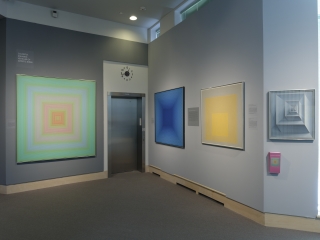Exhibitions Archive
Vehicles of Artistic Ideas
Colorful Squares
While the use of squares as decorative elements can be traced back to the geometric patterns on Greek pottery in 700 B.C.E., the square did not become a dominant compositional element in paintings until the twentieth century. The simplicity and regularity of the square, as both surface and compositional element, might be seen to restrict freedom of representation; however, some artists found that through nuanced coloring, shading, and positioning of squares they were able to convey ideas without distracting the viewer with complicated forms. This installation explores the use of the square in paintings during the 1960s and 1970s to illustrate the range of effects produced through this simple geometric form.
The Art of Public Placemaking
Placemaking is the process of making spaces meaningful to those who experience them. This can be done in small or large ways, by groups or by individuals. Take a moment to think of your favorite place. Maybe it is your childhood backyard, the coffee shop down the street, or a neighbor's front porch. What makes this place meaningful to you? Perhaps it is the social interactions, fond memories, or simply that feel-good sensation you associate with this place. When people attach meaningful ideas and emotions to places, these places take on unique identities. They become a part of our lives and of us.
Small-Scale Art, the Viewer, and the Art World
Rejecting the Diminutive
Small-scale contemporary art has often been ignored or trivialized by scholars and critics. This exhibition looks at seven works that reveal different strategies for rejecting conventional artistic standards. Some of these artists appropriate "insignificant" materials—either everyday or ephemeral in nature—while others employ a hybridized practice to break down traditional institutional boundaries between "high" and "low" art.
Traditional Connections / Contemporary Practice
A dichotomy between craft and art has long been present in critical Western art history, founded largely on a deep-rooted system of aesthetic values. These definitions and values have often ignored the contribution of women artists. The most obvious example of this is women's capacity within the world of craft—a term typically associated with a form of "low art" largely created by women in the domestic sphere to which they have been relegated. Some contemporary women artists have chosen to use traditional techniques associated with craft and utilitarian objects to produce unique and innovative works of art, in the process challenging the largely male-dominated art world to overtly acknowledge their talent as artists.
The Intersections between Black and White
Abstracting Emotion
In Western culture, the color black is a code or symbol sometimes associated with depression, darkness, and despair. Some twentieth-century artists have gone beyond these preconceptions to imbue the color with very personal associations by manipulating the cultural significance of black using the principles of abstraction. The artists harness a range of tones, forms, lines, and edges to create a unique style and form of expression centered upon black.
Artists' Intentions and the Meaning of the Stars and Stripes
What's in a Flag?
The six artists featured in this installation use the flag to make a wide range of points, from a scathing indictment of American foreign policy to a commentary on the paranoia and insecurity of the American middle class. Some of them, intentionally or not, challenge viewers' presumptions about such a recognizable symbol. With introspection and additional information, the viewer can come closer to understanding the artists' intention and the flags' meanings. The more aware we are of the possibilities, the richer our experience of these works will be.


